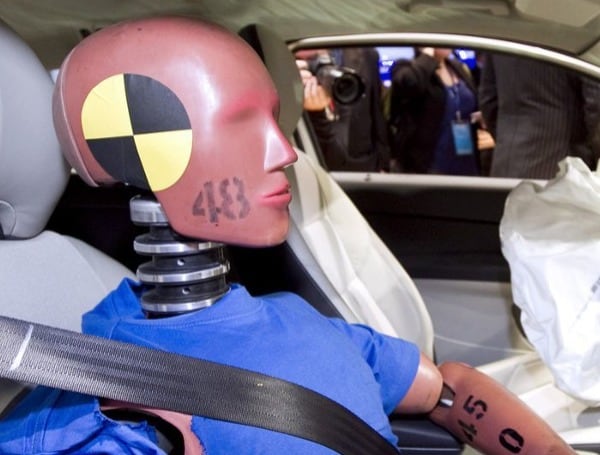At some point Americans who are not progressives must consider one of two possibilities: either the left-wingers are soundly trolling the rest of us or they have literally gone off the deep end.
Del. Eleanor Holmes Norton offers an example.
Norton, who is the non-voting Democratic delegate representing Washington, D.C., in Congress, believes America is utterly failing women in one realm.
Car crashes. But not as victims or even drivers.
Rather, as The Washington Times noted, Norton “wants to see greater gender parity in crash-test dummies.”
Norton, who is chairwoman of the House Transportation subcommittee over highways and mass transit, argues our vehicle makers and crash-test monitors must “ensure vehicle safety standards are designed with women in mind as well as men.”
“Women have achieved equality on the road when it comes to driving, but when it comes to safety testing to keep them safe on the road, they are nowhere near achieving equality,” Norton said in a statement as she advocated for a federal law to bring gender parity to crash-test dummies.
It’s an odd thing, since many Democrats argue gender is irrelevant in, say, women’s sports, or in giving birth.
Nevertheless, Norton added, “Crash-test standards are incredibly antiquated, and we must update these standards now, especially as more people return to their daily commute in the next few months.”
The Times referenced a National Highway Traffic Safety Administration study that recently found female drivers or front-seat passengers are 17 percent more likely to be killed than their male counterparts in car crashes.
Yet the Insurance Institute for Highway Safety, which advocates for insurers, noted in a report published in March that “many more men than women die each year in motor vehicle crashes.”
In 2019, the last year for which the group had data, the IIHS pointed out that 71 percent of crash fatalities were men, and 71 percent of deaths in passenger vehicle wrecks were men.
“Men typically drive more miles than women and are more likely to engage in risky driving practices, including not using safety belts, driving while impaired by alcohol, and speeding. Crashes involving male drivers often are more severe than those involving female drivers,” the group pointed out.
“However, females are more likely than males to be killed or injured in crashes of equal severity, although sex differences in fatality risk diminish with age.”
But that was posted after another IIHS report that showed other, non-gender factors were attributable to potentially higher numbers of fatalities and injuries among women.
“Women are much more likely than men to suffer a serious injury when they are involved in a crash, but much of the heightened risk is related to the types of vehicles women drive and the circumstances of their crashes, rather than physical differences,” the IIHS report maintained.
Jessica Jermakian, the IIHS vice president of vehicle research and one of the study’s authors, noted, “Our study shows that today’s crash-testing programs have helped women as much as men.”
She acknowledged that women are “substantially more likely” to suffer leg injuries in crashes, a concern that warrants additional study.
The IIHS report noted that on a pre-crash basis women are 20 to 28 percent more likely than men to be killed and 37 to 73 percent more likely to be seriously injured after adjusting for speed and other factors.
Yet, the report added, “when IIHS researchers limited the comparison to similar crashes, they found those discrepancies mostly disappeared and that crashworthiness improvements have benefited men and women more or less equally.”
Said Jermakian, “The numbers indicate that women more often drive smaller, lighter cars and that they’re more likely than men to be driving the struck vehicle in side-impact and front-into-rear crashes.
“Once you account for that,” she added, “the difference in the odds of most injuries narrows dramatically.”
Much like the so-called “gender pay gap” disappears when you equal out employment factors such as age, experience, education and geography.
The IIHS study also pointed out, “The benefits of a more crashworthy vehicle were greater for women for most types of serious injuries. These results are in line with previous research that shows serious and fatal injury risk has declined more for women than men as vehicles have gotten safer.”
So perhaps, in contrast to the idea expressed by Norton and the rest of the wokesters about gendered dummies, if carmakers can design a vehicle that can protect men from their own risky, hellbent, hare-brained driving tendencies, we all benefit.
Support journalism by clicking here to our gofundme or sign up for our free newsletter by clicking here
Android Users, Click Here To Download The Free Press App And Never Miss A Story. It’s Free And Coming To Apple Users Soon.

